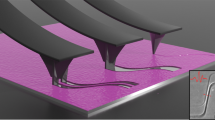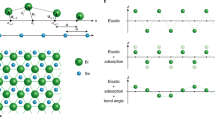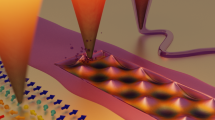Abstract
Crack formation drives material failure and is often regarded as a process to be avoided1,2,3. However, closer examination of cracking phenomena has revealed exquisitely intricate patterns such as spirals4, oscillating5,6,7 and branched7 fracture paths and fractal geometries8. Here we demonstrate the controlled initiation, propagation and termination of a variety of channelled crack patterns in a film/substrate system9,10,11 comprising a silicon nitride thin film deposited on a silicon substrate using low-pressure chemical vapour deposition. Micro-notches etched into the silicon substrate concentrated stress for crack initiation, which occurred spontaneously during deposition of the silicon nitride layer. We reproducibly created three distinct crack morphologies—straight, oscillatory and orderly bifurcated (stitchlike)—through careful selection of processing conditions and parameters. We induced direction changes by changing the system parameters, and we terminated propagation at pre-formed multi-step crack stops. We believe that our patterning technique presents new opportunities in nanofabrication and offers a starting point for atomic-scale pattern formation12, which would be difficult even with current state-of-the-art nanofabrication methodologies.
This is a preview of subscription content, access via your institution
Access options
Subscribe to this journal
Receive 51 print issues and online access
$199.00 per year
only $3.90 per issue
Buy this article
- Purchase on Springer Link
- Instant access to full article PDF
Prices may be subject to local taxes which are calculated during checkout




Similar content being viewed by others
References
Hellemans, A. Cracks: more than just a clean break. Science 281, 943–944 (1998)
Livne, A., Bouchbinder, E., Svetlizky, I. & Fineberg, J. The near-tip fields of fast cracks. Science 327, 1359–1363 (2010)
Broek, D. Elementary Engineering Fracture Mechanics 4th edn (Martinus Nijhoff Publishers, 1986)
Leung, K.-T., Jozsa, L., Ravasz, M. & Neda, Z. Pattern formation: spiral cracks without twisting. Nature 410, 166 (2001)
Deegan, R. D., Petersan, P. J., Marder, M. & Swinney, H. L. Oscillating fracture paths in rubber. Phys. Rev. Lett. 88, 014304 (2001)
Deegan, R. D. et al. Wavy and rough cracks in silicon. Phys. Rev. E 67, 066209 (2003)
Yuse, A. & Sano, M. Transition between crack patterns in quenched glass plates. Nature 362, 329–331 (1993)
Skjeltorp, A. T. & Meakin, P. Fracture in microsphere monolayers studied by experiment and computer simulation. Nature 335, 424–426 (1988)
Hutchinson, J. W. & Suo, Z. Mixed mode cracking in layered materials. Adv. Appl. Mech. 29, 63–191 (1991)
Beuth, J. L., Jr Cracking of thin bonded films in residual tension. Int. J. Solids Struct. 29, 1657–1675 (1992)
Ye, T., Suo, Z. & Evans, A. G. Thin film cracking and the roles of substrate and interface. Int. J. Solids Struct. 29, 2639–2648 (1992)
Ball, P. Nature’s Patterns: a Tapestry in Three Parts (Oxford Univ. Press, 2009)
Marder, M. & Fineberg, J. How things break. Phys. Today 49, 24–29 (1996)
Bouchbinder, E., Fineberg, J. & Marder, M. Dynamics of simple cracks. Annu. Rev. Cond. Matter Phys. 1, 371–395 (2010)
Sharon, E., Gross, S. P. & Fineberg, J. Local crack branching as a mechanism for instability in dynamic fracture. Phys. Rev. Lett. 74, 5096–5099 (1995)
Yuse, A. & Sano, M. Instabilities of quasi-static crack patterns in quenched glass plates. Physica D 108, 365–378 (1997)
Kobeda, E. & Irene, E. A. Intrinsic SiO2 film stress measurements on thermally oxidized Si. J. Vac. Sci. Technol. B 5, 15–19 (1987)
Cotterell, B. & Rice, J. R. Slightly curved or kinked cracks. Int. J. Fract. 16, 155–169 (1980)
He, M.-Y. & Hutchison, J. W. Kinking of a crack out of an interface. J. Appl. Mech. 56, 270–278 (1989)
Choi, S. T. & Earmme, Y. Y. Elastic study on singularities interacting with interfaces using alternating technique: Part I. Anisotropic trimaterial. Int. J. Solids Struct. 39, 943–957 (2002)
Choi, S. T. & Earmme, Y. Y. Elastic study on singularities interacting with interfaces using alternating technique: Part II. Isotropic trimaterial. Int. J. Solids Struct. 39, 1199–1211 (2002)
Faber, K. T. & Evans, A. G. Crack deflection processes – I. Theory. Acta Metall. 31, 565–576 (1983)
Green, D. J., Tandon, R. & Sglavo, V. M. Crack arrest and multiple cracking in glass through the use of designed residual stress profiles. Science 283, 1295–1297 (1999)
Rao, M. P., Sánchez-Herencia, A. J., Beltz, G. E., McMeeking, R. M. & Lange, F. F. Laminar ceramics that exhibit a threshold strength. Science 286, 102–105 (1999)
Clegg, W. J. Controlling cracks in ceramics. Science 286, 1097–1099 (1999)
Son, Y. et al. Nanoscale electronics: digital fabrication by direct femtosecond laser processing of metal nanoparticles. Adv. Mater. 23, 3176–3181 (2011)
Xia, Y. et al. One dimensional nanostructures: synthesis, characterization, and applications. Adv. Mater. 15, 353–389 (2003)
Nam, S. W. et al. Sub-10-nm nanochannels by self-sealing and self-limiting atomic layer deposition. Nano Lett. 10, 3324–3329 (2010)
Marder, M. Cracks takes a new turn. Nature 362, 295–296 (1993)
Buehler, M. J. & Gao, H. Dynamical fracture instabilities due to local hyperelasticity at crack tips. Nature 439, 307–310 (2006)
Acknowledgements
This research was supported by Creative Research Initiatives (Research Center of MEMS Space Telescope) of MEST/NRF. We thank Y.Y. Earmme at KAIST for discussions and J. Yeo, Y. D. Suh, S. Hong, P. Lee, Y. Rho and J.-A. Jeon for technical assistance with fabrications and experiments.
Author information
Authors and Affiliations
Contributions
K.H.N. conceived the study, discovered the control of cracking using microfabrication, conducted experiments and theoretical study of the phenomena, and invented DISL. K.H.N. and I.H.P. designed mask patterns for photolithography and fabricated samples. S.H.K. did the post-processing and conducted experiments. K.H.N. and S.H.K. wrote the paper and discussed the results. All authors commented on the manuscript.
Corresponding authors
Ethics declarations
Competing interests
The authors declare no competing financial interests.
Supplementary information
Supplementary Information
This file contains Supplementary Methods, Supplementary Discussions 1-10, Supplementary Figures 1-11 and Supplementary References. (PDF 1294 kb)
Supplementary Movie
This Supplementary Movie file shows a video clip of wafer size long oscillation. (MOV 5508 kb)
Rights and permissions
About this article
Cite this article
Nam, K., Park, I. & Ko, S. Patterning by controlled cracking. Nature 485, 221–224 (2012). https://doi.org/10.1038/nature11002
Received:
Accepted:
Published:
Issue Date:
DOI: https://doi.org/10.1038/nature11002
This article is cited by
-
Programming crack patterns with light in colloidal plasmonic films
Nature Communications (2024)
-
Achieving tissue-level softness on stretchable electronics through a generalizable soft interlayer design
Nature Communications (2023)
-
Ultrasensitive crack-based strain sensors: mechanism, performance, and biomedical applications
Journal of Mechanical Science and Technology (2022)
-
Strain-resilient electrical functionality in thin-film metal electrodes using two-dimensional interlayers
Nature Electronics (2021)
-
Controlled nano-cracking actuated by an in-plane voltage
Science China Information Sciences (2021)
Comments
By submitting a comment you agree to abide by our Terms and Community Guidelines. If you find something abusive or that does not comply with our terms or guidelines please flag it as inappropriate.



